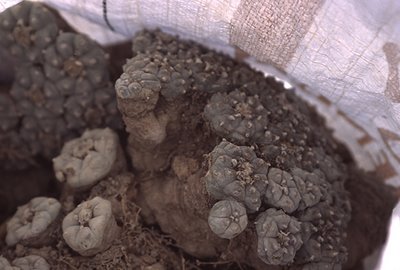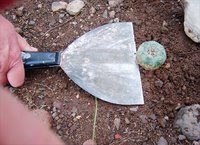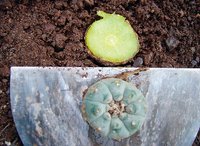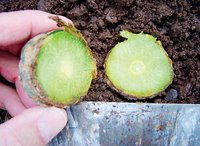Once a year groups of Huichols (an indigenous people with a population of about 20,000) embark on a pilgrimage to collect peyote, a trip taking them approximately 300 miles (~480 km) from their home in the Sierra Madre Occidental in western Mexico to the peyote fields in San Luis Potosí (a sacred area known as Wirikuta). The rituals surrounding the pilgrimage have been described in detail by e.g. Carl Lumholtz and Ted Anderson, but Nicola Frioli’s photos are the best pictorial documentation of the journey I’ve seen yet.

Huichol woman holding large peyote

Sack full of peyote
The images are courtesy of Nicola “Okin” Frioli (you can find more pictures at his home page by selecting your language, e.g. “english”, then select “Reportages” and “Mexico”, finally click on “In the Sacred Land of the Blue Deer”
It’s interesting to compare the above plants with the peyote harvesting technique recommended by modern research.
Thursday, January 18, 2007
Huichol peyote pilgrimage
Monday, December 04, 2006
Proper peyote harvesting technique
Lophophora williamsii (peyote) populations have diminished in large areas of South Texas where peyoteros harvest the cactus for ceremonial use by the Native American Church. Habitat destruction caused by urban development, rootplowing, etc., account for much of the reduction, but the regulated commercial harvest of peyote is also taking its toll. Some harvesters cut the peyote too low (it can be very hard to tell where the shoot ends and the root begin) - consequently many of the decapitated plants will not regenerate new stems and are left to die.
To address this problem Martin Terry and James D. Mauseth have investigated the proper technique for harvesting peyote, and found that the cactus must be cut off at or immediately below its base, leaving the subterranean portion of the plant (including all or most of the subterranean part of the stem) in the ground to regenerate new crowns. Their harvesting technique is outlined below.
 Plant about to be cut transversely at the base of the crown (the photosynthetic part of the stem), i.e., at ground level.
Plant about to be cut transversely at the base of the crown (the photosynthetic part of the stem), i.e., at ground level.
 Cut has been made parallel to the ground surface, and the harvested crown (below) has been removed from the subterranean portion of the stem (above, remaining in the ground). The cut surface shows a cross section of the vascular cylinder (ring of yellow tissue near center of stem), the pith within the vascular cylinder, and the yellowish green parenchymal tissue of the cortex of the stem (between vascular ring and epidermis).
Cut has been made parallel to the ground surface, and the harvested crown (below) has been removed from the subterranean portion of the stem (above, remaining in the ground). The cut surface shows a cross section of the vascular cylinder (ring of yellow tissue near center of stem), the pith within the vascular cylinder, and the yellowish green parenchymal tissue of the cortex of the stem (between vascular ring and epidermis).
 The underside of the harvested crown (left) shows a very narrow (2–3 mm wide) ring of bark at the perimeter of the cut surface, indicating that the cut was barely below the base of the crown, in the uppermost portion of subterranean stem. The cut surfaces match, except that crown parenchyma (left) is slightly greener due to higher chlorophyll content, whereas the subterranean stem parenchyma (right) is more yellowish.
The underside of the harvested crown (left) shows a very narrow (2–3 mm wide) ring of bark at the perimeter of the cut surface, indicating that the cut was barely below the base of the crown, in the uppermost portion of subterranean stem. The cut surfaces match, except that crown parenchyma (left) is slightly greener due to higher chlorophyll content, whereas the subterranean stem parenchyma (right) is more yellowish.
 Two young peyote crowns (“pups”) regenerating by lateral branching from the upper edge of the subterranean stem of a plant that was decapitated 7.5 months previously. This plant is the same individual shown in the 3 previous pictures. Each of the new crowns is ca. 1.5 cm in diameter.
Two young peyote crowns (“pups”) regenerating by lateral branching from the upper edge of the subterranean stem of a plant that was decapitated 7.5 months previously. This plant is the same individual shown in the 3 previous pictures. Each of the new crowns is ca. 1.5 cm in diameter.
If the peyote is cut too deep no tubercles are left to sprout and continue growing after the top has been removed, i.e. the closer to soil level the plant is cut, the greater the chances are that the remaining parts of the plant will retain healthy tubercles and be able to re-grow new crowns. Terry and Mauseth base their technique on detailed studies of the anatomy of root, shoot and hypocotyl (region between shoot and root) and also give recommendations on how to distinguish shoots from roots without actually cutting the plant open.
References
Martin Terry, James D. Mauseth (2006), “Root-shoot anatomy and post-harvest vegetative clonal development in Lophophora williamsii (Cactaceae: Cacteae): implications for conservation”, Sida, Contributions to Botany 22, 565-592
(Download the article from Sida - 19.2 MB)
Sylvia Moreno, “In Deep South Texas, peyote harvest dwindling”, Seattle Times
See also How to sustainably harvest Lophophora williamsii (Peyote) from Kadas Garden.

Monday, March 27, 2006
Prehistoric peyote use
I’m growing my Lophophora plants for aesthetics, but I have to admit that the mescaline content and the traditional ceremonial use by Native Americans are fascinating aspects. Apparently peyote use is ancient; archaeological discoveries in caves and rock shelters in the lower Pecos River region, Texas indicate that peyote use dates thousands of years back.
Peyote buttons recovered from a rock shelter in the lower Pecos River region (photo reproduced from Boyd et al.)
Recently El-Seedi et al. subjected samples from two archaeological specimens of peyote buttons to radiocarbon dating and alkaloid analysis. The specimens were discovered in Shumla Cave No. 5 on the Rio Grande, Texas and now reside in the collection of the Witte Museum in San Antonio, Texas – see photo above. The peyote samples were dated to be in the time interval 3780–3660 BC, and the alkaloid yield was approximately 2% in both samples. The only peyote alkaloid that could be identified was mescaline, i.e. no traces of the other major peyote tetrahydroisoquinoline alkaloids like lophophorine, anhalonine, pellotine, and anhalonidine could be found.
The authors conclude “From a scientific point of view, the now studied ‘mescal buttons’ appears to be the oldest plant drugs which ever yielded a major bioactive compound upon phytochemical analysis. From a cultural perspective, our identification of mescaline strengthens the evidence that native North Americans already recognized and valued the psychotropic properties of the peyote cactus 5700 years ago.”
The ancient use of peyote is also supported by Boyd et al. who argue that Lower Pecos pictographs (found in the same area as the archaeological peyote specimens) can be seen as evidence for early peyotism.
References
Hesham R. El-Seedi, Peter A.G.M. De Smet, Olof Beck, Göran Possnert, Jan G. Bruhn (2005), “Prehistoric peyote use: Alkaloid analysis and radiocarbon dating of archaeological specimens of Lophophora from Texas”, Journal of Ethnopharmacology 101, 238–242
Carolyn E. Boyd, J. Philip Bering (1996), “Medicinal and hallucinogenic plants identified in the sediments and pictographs of the Lower Pecos, Texas Archaic”, Antiquity 70, 256-75
All Time Most Popular Posts
-
On various occasions I've been asked what growing media I'm using for my cactus plants. I don't have a set soil mix recipe as su...
-
Lophophora williamsii (peyote) populations have diminished in large areas of South Texas where peyoteros harvest the cactus for ceremonial ...
-
Below is a list of retailers/nurseries selling cactus seed and plants. I've only listed vendors I've done business with. If you ar...
-
Most cacti are easily grown from seed - and with a little patience and care they can be grown into beautiful plants. Lophophora williamsi...
-
In last month’s post on the troubled Texan peyoteros I referred to Anderson’s article on the peyote situation in Texas. Given the importanc...
-
Yet another slightly off topic and probably not entirely politically correct post, but I couldn’t help noticing the similarity of my monstr...
-
Flowering stand of San Pedro cacti (Trichocereus pachanoi) To me the main draw of the San Pedro cactus ( Trichocereus pachanoi (syn. Ech...
-
In the June 2008 issue of the Cactus & Co magazine Jaroslav Šnicer, Jaroslav Bohata, and Vojtěch Myšák described a new Lophophora spec...
-
There seems to be an increased focus on the alarming Texas peyote situation. A couple of weeks ago the Houston Press published a mournful, i...
-
I spent two weeks working in Delhi, India during January. I had one weekend off and had planned to spend it in Delhi at my own leisure, but ...


















